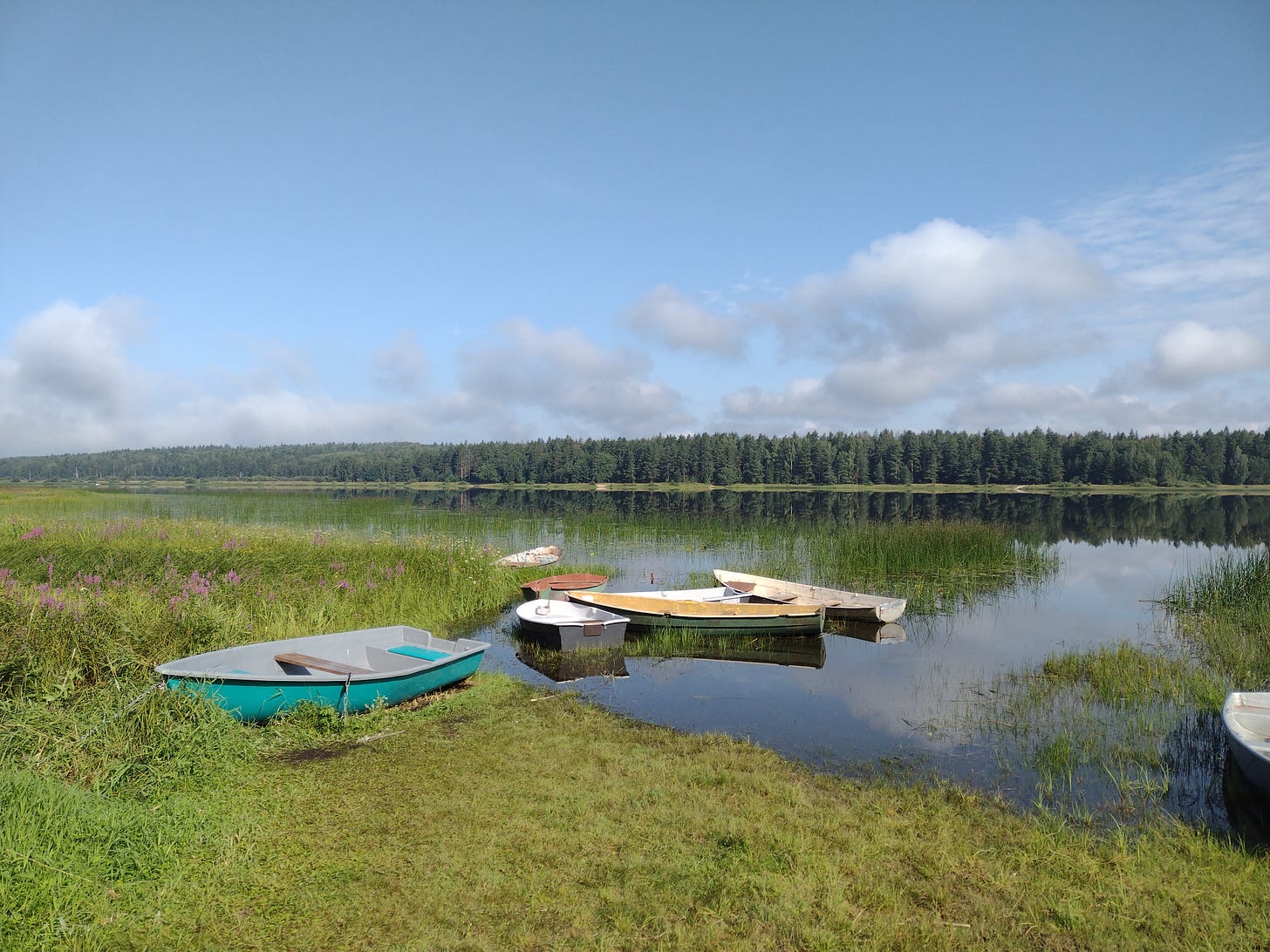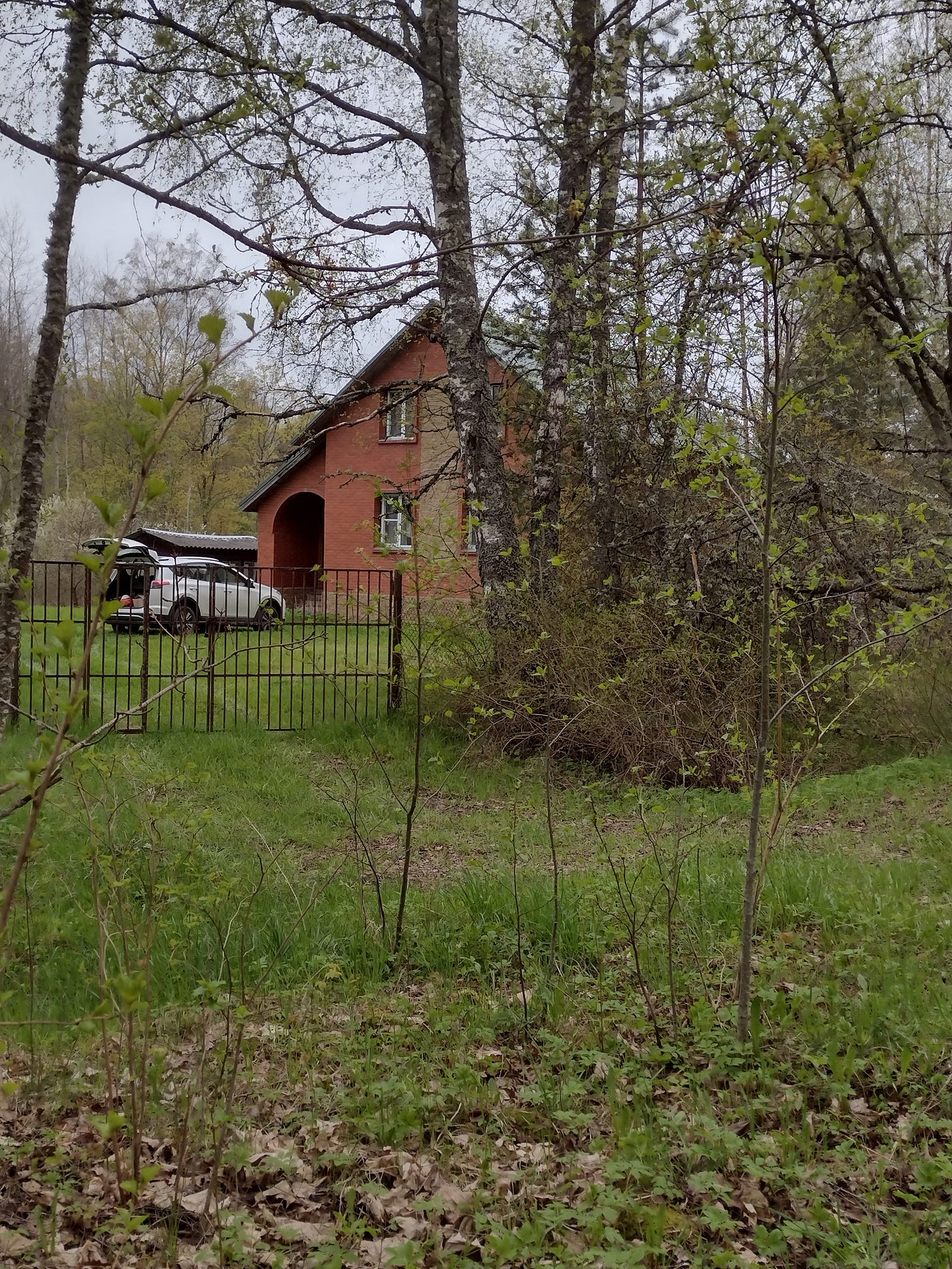Note from the author: I asked a friend who lived in the US for over 30 years, but a few years ago relocated to her ancestral village in Russia, to tell me what she thinks about rural Russia today. Here’s what she wrote (I fed it to Google Translate and then lightly edited it). All the photos were taken by my friend.
My observations will be limited to a small village in the Leningrad region, which is not quite typical. The Luga district, within which the village is located, has long been a resort area and despite its remoteness from the Northern Capital (that is, St. Petersburg)—150 km—is popular as a summer vacation spot due to its environment, climate, and relatively good transport accessibility. It has many lakes, rivers and pine forests.
Today, there are still several enterprises in Luga that provide employment for the local population and, of course, there is also a lot of imported labor. Alas.
My village has not been poor throughout its history. Since the 1990s the village grew a lot. I think it is now almost two times as big. This is mainly due to St. Petersburg, but there are also new arrivals from other regions. About 120 people are registered as permanent residents, mostly elderly.
There is no official work in the village. In the spring and summer season, you can earn money by providing various services, such as construction, cleaning the territory, mowing the grass, tending the garden etc. At the same time, all of the above is quite an expensive pleasure.
You can't sign up local healthy men for this work, and there are almost none in the village. The few men who live there permanently are professionals, who work remotely and earn good salaries.
The prices for land and real estate are quite high, around a thousand dollars per hundred square meters. Thus, a typical plot of 0.2 ha costs 20+ thousand dollars. This is just land without a house.
Nobody is seriously involved in commercial agriculture, growing food only for themselves. I am convinced that if there are still small farmers in our country, they survive against all odds…
Things are very, very bad with the cooperatives, but a single farmer cannot resist the robbery of middlemen. The prices they offer are laughably low. At the same time, the prices for some produce in the store are almost the same as in the USA.
During the Soviet period the local collective farm, which also incorporated two neighboring villages, operated three dairy farms, a calf barn, more than a dozen fields with various vegetables and grains, a medical center, a club, a library, an elementary school, and a store.
I write this and tears come to my eyes, because everything was destroyed, abandoned and sold.
So, it turns out that it is impossible to live on the land with rural labor. That is why the farms that worked perfectly well in the USSR are in ruins, and the fields are overgrown with weeds. This is the horror and pain of this country. And what are the prospects for the development of the village in this state of affairs? Some prospects are only near big rich cities, where there is land for summer cottages or an opportunity to work remotely. However, in any case, there is simply NO social infrastructure for such a life. None at all. It is understandable why people move to big cities, where there are opportunities for young people, children and old people. However, a huge number of people would be happier living in small towns and villages if there were conditions for a normal life.
On the positive note. Most people live better (compared to the USSR period). Many have very nice houses, almost every house has a car (or even two). The city of Luga is being renovated, it is becoming cleaner and more “groomed.” Unfortunately, our roads are still in a terrible state.











Random thoughts inspired by comments:
1. Agenda: things to be done. Of course, everybody on Substack (or any social media) has an agenda, or they wouldn't be here.
3. There is a great diversity of voices and themes. An unsystematic reading of social media will inevitably give you a distorted idea of what people (all people, or all that are on social media) think. The proverbial echo chambers rule.
3. I also live in Europe (Austria) half time. Life is comfortable and well-regulated. It's hard to imagine Austrians rebelling and starting a civil war. But it was equally hard to imagine the Yellow Vest movement in France before it happened. So what was the energy that fueled it?
4. Indicators of instability, such as antigovernmental demonstrations and violent riots are trending up everywhere in Europe. Will they simply blow out, or are they a precursor of something more serious? I don't know.
I feel like everyone who posts on Substack has an agenda to push or an ax to grind.
I see stories like this about the USA with almost exactly the same theme and tone; pining for better times when life was easier or looking forward to the future with dread.
None of these match my experience living in the United States or in Europe (Spain).
I am squarely in the middle class; 57 years old and still working for the Man.
I also own a small business with over 15 employees which is far more difficult than merely being employed.
Life would be much easier if I just punched a clock every day.
Life felt easier in Europe where nobody I know aspired to own a small business.
Everyone aspires for a government job.
But, since many people live in large, multi-generational homes with extended family, there’s relatively little homelessness or immiseration.
I know my view is out of the mainstream; everybody wants to predict a Civil War in the near future.
I just don’t see it.
Plus, with Social Media, everybody has a voice.
Perhaps the ability to go on Facebook or Substack and rant will let people vent their vitriol and will keep them from going out in the streets and punching a cop.